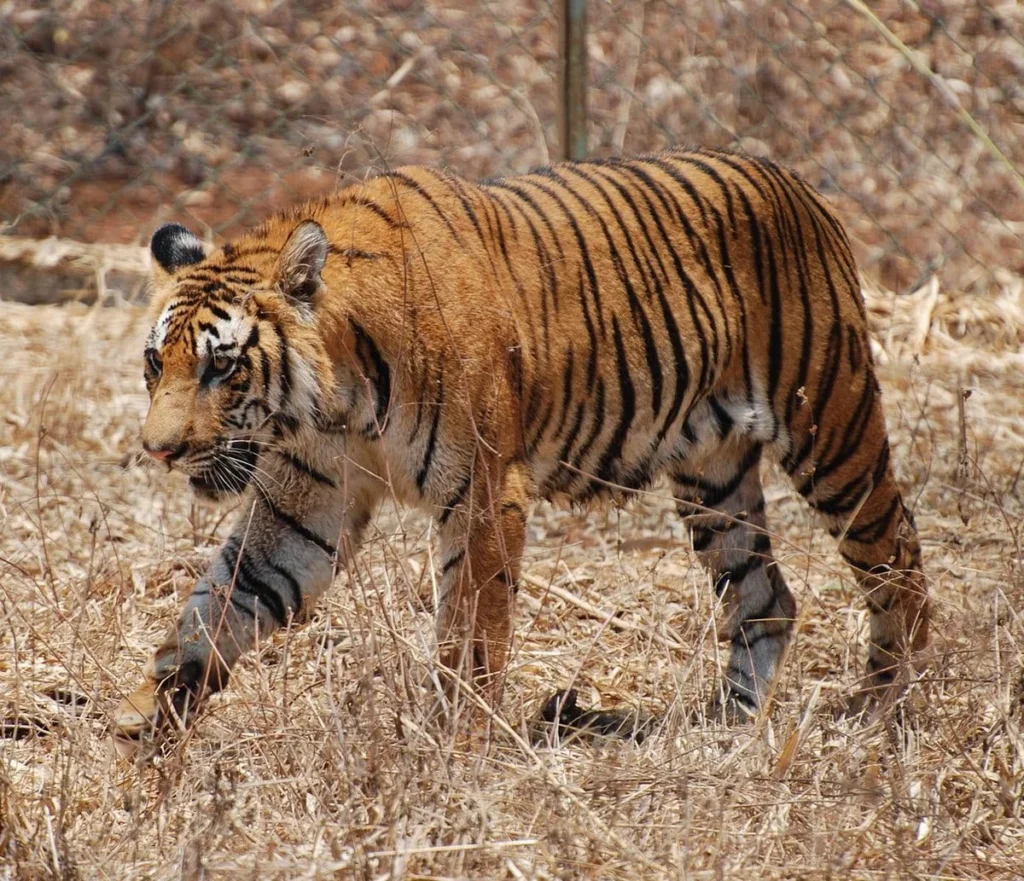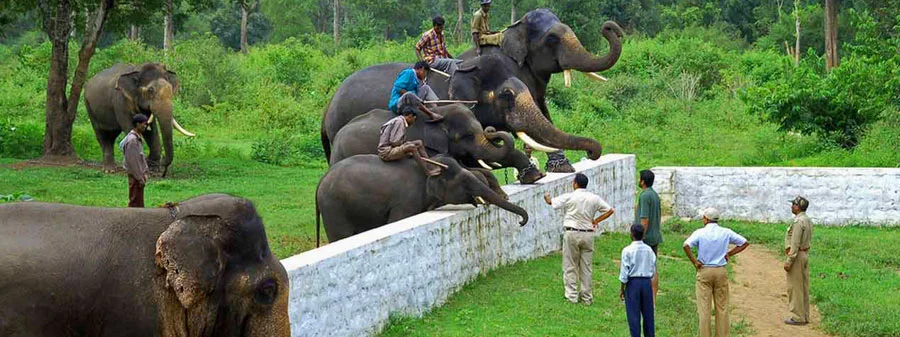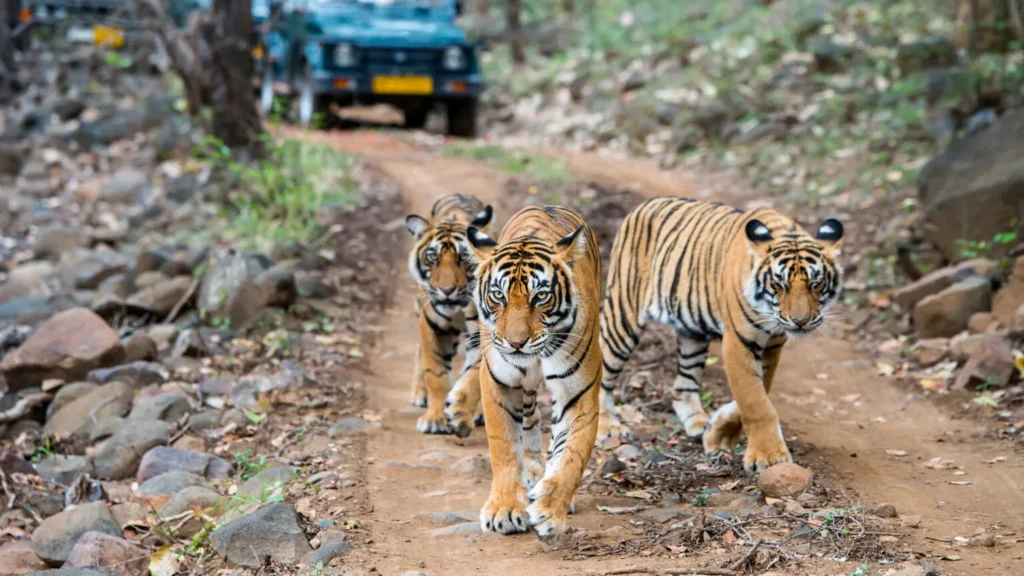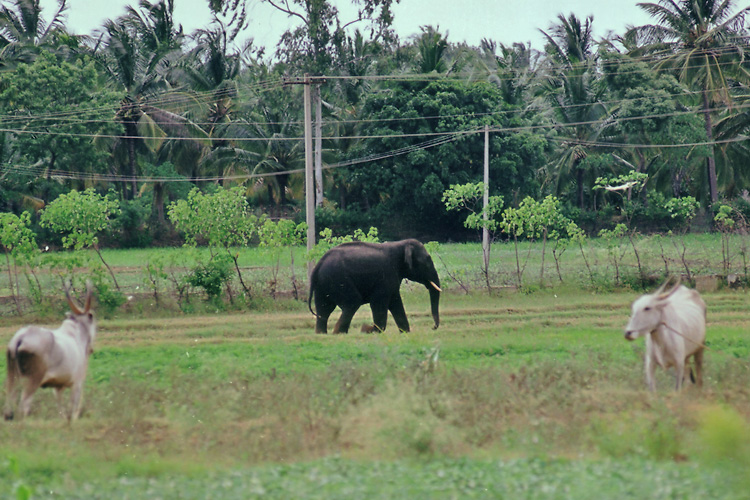Bandipur Projects
Love watching animals in the wild? Come and enjoy the safari with your family and friends. Leave the booking worries to us—we’ll take care of it!
Bandipur National Park, a vital conservation area in Karnataka, South of India, is known for running many successful Bandipur conservation projects. The main aim of each of these projects is to protect the wildlife and the rich biodiversity of the region. Bandipur National Park was launched as part of the Project Tiger initiative focusing on safeguarding the population of tigers. This was undertaken by habitat restoration, putting anti-poaching measures in place, and scientific monitoring. The park, along with Mudumalai and Nagarhole tiger reserves, works together to create a connected and functional tiger reserve.
Project tiger Bandipur is just one initiative running here for conservation of wildlife. Another major project is the protection of the elephant corridor linking Bandipur with nearby forests in the Nilgiri Biosphere Reserve. This lets the elephants migrate safely without much human interaction, so there are no or fewer injuries due to elephant and human encounters. Moreover, the conservation projects in the park also include anti-poaching measures like patrolling 24*7 or using drones or camera traps to monitor illegal activities and reduce poaching.
In addition, Bandipur also focuses on eco-tourism and community involvement by promoting eco-friendly use of the land, like sustainable tourism. All this reduces enrichment and creates a better relationship between conservation efforts and local communities. The page below talks about major conservation projects at Bandipur while also shedding light on how visitors can be part of the efforts to preserve the wildlife here.
Key Conservation Initiatives

Tiger Conservation Project
The tiger conservation project in Bandipur National Park is part of the Project Tiger, Bandipur initiative safeguarding the tiger population. The project was launched in 1973 and was one of the key tiger reserves in India. It focuses on maintaining a tiger population necessary for preserving the entire ecosystem. The project also emphasizes habitat restoration in Bandipur, anti-poaching patrols, and other scientific monitoring via tracking systems and camera traps.
The efforts are made for reducing human-wildlife conflicts, especially between local communities and tigers. It helps by creating buffer zones while strengthening laws to prevent poaching. The tiger reserve also collaborates with neighboring reserves like Mudumalai and Nagarhole, as tigers roam across state boundaries. The conservation projects monitor the tiger behavior and health, and the park participates in the generic studies improving breeding strategies. The efforts are supported by NGOs and government funding and help in maintaining Bandipur’s role as the most favored tiger sanctuary.
Elephant Corridor and Habitat Protection
Elephant corridors are critical for the safe movement of elephants between different habitats, reducing human-elephant conflict and ensuring genetic diversity. Bandipur National Park, part of the larger Nilgiri Biosphere Reserve, plays a vital role in these corridors, connecting elephants with adjacent reserves like Mudumalai and Nagarahole. The elephant corridor protects migratory routes used by elephants, allowing them to travel safely between forests for feeding, mating, and seasonal migration.
Habitat protection efforts include the creation of wildlife corridors, which minimize conflicts with humans, especially farmers. The park works on restoring degraded areas and addressing encroachments that limit elephant movement. Collaborations with local communities help in reducing agricultural damage and promoting wildlife-friendly land use. Additionally, the reserve has designated elephant corridors that link forests, reducing the risk of poaching and fostering healthier, more connected elephant populations across southern India.


Anti-Poaching Measures
Anti-poaching measures in Bandipur National Park are important for maintaining the reserve’s biodiversity, specifically for species like elephants, tigers, and other endangered wildlife. The park implements multi-layered surveillance strategies, including the use of drones, camera traps, and forest patrols for tracking and monitoring illegal activities. A dedicated team of forest rangers and anti-poaching squads works round-the-clock to prevent illegal hunting and trading of wildlife parts.
The national park has established intelligence networks to detect poaching syndicates and disrupt their operations. In collaboration with local wildlife protection agencies and local police, Bandipur has successfully increased arrests of poachers while reducing incidents of wildlife trafficking. Additionally, Bandipur’s management focuses on increasing awareness amongst the public and encouraging local communities to act as wildlife protectors reporting illegal activities. Effective anti-poaching initiatives are complemented by legal measures ensuring reduced crimes.
Wildlife-Friendly Land Use
The buffer zones in the park have been designed to put a limit on the infrastructure development and agricultural expansion. Local communities will adopt eco-friendly farming techniques like organic farming, minimizing environmental impact. It also reduces encroachment into the forested area. The park also advocates for forest conservation agreements with the local farmers, offering them incentives. It helps with protecting wildlife habitats and land stewardship. Some areas also promote agroforestry, allowing people to grow their crops alongside trees supporting local wildlife. Moreover, village relocation programs initiated by the government reduce human-wildlife conflict, moving people from their critical wildlife habitats to better and safer places. It is a holistic approach aiming to maintain the ecological balance and, at the same time, improve the livelihoods of the communities staying near the park. Thus, this fosters long-term sustainability in conservation. It is one of the greatest initiatives ensuring sustainable development and maintaining the ecosystem too.

Community and Eco-Tourism Initiatives
Bandipur is one of the first nine tiger reserves in the country. It was set up as part of the Project Tiger initiative, and thus, even after three decades, it is at the forefront of eco-tourism. The eco-tourism initiative by the respected organization ensures sustainable tourism without disruption to the wildlife of Bandipur. For this, the tourist part is different from the main reserve. There are two ranges: Bandipur (54 sq km), and the second is GS Betta (28 sq km).
- The Bandipur eco-tourism projects include a safari to expose the tourists to the wildlife of the area. On the other hand, there are other activities like trekking to cater to the tourists looking for recreation.
- Training the local people: Community initiatives also include training the local people in wildlife guiding, hospitality, and helping them develop other skills. This ensures that the local community has the chance to earn a livelihood without compromising on their ethics or leaving their home.
- Building of protective infrastructure: One of the major projects towards wildlife conservation at Bandipur along with community development is building protective infrastructure. This ensures elephants, tigers, and other animals stay away from the locals and tourists, ensuring the safety of both.
- Community awareness programs: NGOs along with government initiatives include creating community awareness programs. This ensures that the locals are educated about the conflict between humans and animals, which can happen. Also, they learn about how to avoid such conflicts while also protecting their crops and farms from the attack of wild animals.
- Water conservation programs: The Bandipur region is known for water scarcity. Therefore, one of the major Bandipur conservation projects is creating a source of water. Using solar-powered pumps to provide water to not just animals but also for irrigation purposes is a dual benefit that this initiative provides to the residents of the park.
- Partnering with the tribe: Bandipur is home to many tribes who still live and work in the area. There are many conservation projects that aim to fight for their rights. Also, they ensure to take into account the opinions of the tribe, ensuring autonomy.
Success Stories
Tiger Population Recover
One of the best success stories of Project Tiger Bandipur is the increase in the population of tigers. When Bandipur National Park was launched under Project Tiger in 11973, the number of tigers here at the park was only 12. However, this number increased to a whopping 126 in 2018. As per the last survey, there are about 173 tigers at Bandipur Tiger Reserve. It is a huge achievement for everyone involved in the conservation of wildlife here.


Capturing the Rare Leopard
Leopards are one of the most intriguing animals, and Bandipur is known for having a rare leopard with the genetic mutation of Heterochromia iridum. That means that the leopard has different-coloured eyes. Fortunately, due to the organization of the wildlife safari in Bandipur National Park, Dhruv Patil, a renowned wildlife photographer, was able to capture a rare photo of him.
Reduction in Human-Wildlife Conflict
Bandipur National Park is an epitome when it comes to creating a balanced and safe environment for both humans and animals. There are many initiatives and plan shaping for the same. For instance, Wild Seve is an initiative that ensures proper documentation for deaths, injuries, and property damage to wildlife. It helps them claim for such unforeseen circumstances. Moreover, the roads near Bandipur are closed off between 9 pm and 6 pm. This ensures there is no interaction between wildlife and humans late at night, leading to injuries to both parties.

How Can Visitors Support Bandipur Conservation Projects Initiatives?
Follow the rules
One of the best ways visitors can support the park is by supporting Bandipur National Park initiatives. The Project Tiger initiative aims to protect the best predator in the world, but there are other endangered species too, requiring safety. So, as a visitor, you can offer support by following all the rules that are there for your and the safety of the wildlife. For instance, there is a rule to not use flash photography while on your wildlife safari. It is important that you follow this rule, ensuring the safety and comfort of the animals.
Not disturbing the wildlife
The main thing a visitor can do is not disturb the wildlife. Do not feed the animals, not even the elephants or monkeys. This is not the place for this, and the animals might attack you if they feel you are disturbing them or are a threat to them.
No littering
Another important thing to do is not loiter in the park. The park is home to many species of birds, mammals, reptiles, and even flora. Thus, loitering in the park can lead to fires or other hygiene issues for the animals. It is best to pick up your waste and dump it in a proper way.
FAQ’s About Bandipur Projects
When did Bandipur complete 50 years as Project Tiger Reserve?
Bandipur Tiger Reserve in Karnataka completed 50 years as a project tiger reserve in 2023 on April 1st. The reserve part of Project Tiger Reserve was launched in 1973 by the then Prime Minister, Indira Gandhi. The aim of the project was to reduce and eventually stop the decline in tigers’ population. At the time of the launch of Project Tiger, there were only 12 tigers. But now there are 173 tigers calling Bandipur their home.
What types of conservation projects are ongoing at Bandipur National Park?
Bandipur National Park has many conservation projects ongoing. These initiatives include:
- Anti-poaching measures: One of the ongoing projects at Bandipur National Park is anti-poaching measures to ensure the population of tigers, elephants, and other endangered species.
- Wildlife protection laws: This project includes creating laws to protect the wildlife of the park.
- Community Involvement: There are a few community initiatives running, including the community in its conservation efforts.
- Wild Seve: This project of wildlife conservation in Karnataka focuses on documentation and processing claims for deaths, injuries, and property damage happening due to wildlife.
- Eco-tourism initiative: There are also a few eco-tourism initiatives running in Bandipur National Park, helping create a sustainable and memorable journey amidst the national park for all.
Which is the largest tiger reserve in Karnataka?
The largest tiger reserve in Karnataka is the Nagarhole Tiger Reserve, or Rajiv Gandhi National Park, spanning over an area of 1,200 square kilometers. It is situated in the western ghats and is part of the stunning Nilgiri Biosphere Reserve. It is known for its rich biodiversity, including a significant population of elephants, tigers, and other wildlife, making it a key conservation area in India.
Which river flows through Bandipur National Park?
The park is home to many rivers, like the Kabini River in the north and the Moyar River in the south. Moreover, the Nugu River runs via the park. The highest point in the Bandipur Park is on a hill called Himavad Gopalaswamy Betta. At the summit, there is a Hindu temple. The Bandipur National Park has a tropical climate with dry and wet seasons.
How does Bandipur National Park manage water scarcity for wildlife?
The summer sun is scorching hot during the summers at Bandipur National Park. The hot summer means that not just humans but also the animals and birds require to keep themselves hydrated in this endless summer. The individuals and institutions are implementing ways to tackle the scarcity of water. Bandipur National Park in Karnataka uses an eco-friendly alternative for keeping animals hydrated. Since a few years, the park has been using solar energy for pumping water, and the forest department uses it to power 45 ponds and lakes. The solar energy setup here generates about five kilowatts of energy, pumping almost 30,000 litres of water every day. The initiates are installing the pumps next to the water bodies like ponds and lakes. The solar pumps aid in supplying water straight into these river bodies. The waterholes have emerged as the lifeline to animals in the area. This also helps visitors view the animals as they come to quench their thirst. There are 85 lakes in the park, allowing the various species of animals here to quench their thirst.
Are local communities involved in conservation efforts?
Yes, local communities are actively involved in conservation efforts in tiger reserves like Nagarahole. These communities often play a vital role in wildlife protection, habitat restoration, and eco-tourism activities. Collaborative efforts include providing sustainable livelihoods through eco-tourism, forest patrols, and supporting anti-poaching initiatives. Programs also focus on raising awareness about wildlife conservation and mitigating human-wildlife conflict, ensuring that local people benefit from and contribute to long-term conservation goals.
Can visitors contribute to Bandipur’s conservation projects?
Yes, visitors to Bandipur Tiger Reserve can contribute to its conservation efforts in several ways. The reserve encourages eco-friendly tourism practices, and visitors can support conservation by:
- Eco-tourism Fees: Entry fees, safari charges, and other tourism-related funds directly support conservation activities, including anti-poaching measures and habitat preservation.
- Awareness Programs: Visitors can participate in guided tours that emphasize the importance of conservation, helping to spread awareness about wildlife protection and responsible tourism.
- Volunteering: Some NGOs and conservation organizations collaborate with Bandipur to offer volunteer opportunities for visitors interested in hands-on conservation work, such as wildlife monitoring and community outreach.
By supporting local businesses, choosing sustainable travel options, and following park guidelines, visitors can make a positive impact on Bandipur’s ongoing conservation projects.
What are the main challenges in conserving Bandipur’s wildlife?
Bandipur Tiger Reserve faces many challenges, including:
- Human-wildlife conflict: Bandipur is near human settlements, leading to frequent encounters between wildlife and local communities. Tigers and elephants often result in crop damage, human casualties, and livestock killings.
- Illegal activities and poaching: Poaching for tigers, ivory, pelts, and more remains a significant threat. Bandipur anti-poaching efforts have reduced such instances. Yet, these activities are still a reason for concern.
- Habitat fragmentation: Expansion of infrastructure projects and human settlements such as railways and roads fragment wildlife habitats, hindering access and animal movement. Bandipur Habitat Restoration ensures a solution for the same.
- Climate change: The changing weather patterns will alter the availability of food and water sources. Thus, it impacts both the wildlife of animals and their habits, so conservation becomes complex.
- Tourism pressure: Eco-tourism provides essential funding for conservation. The unregulated tourism leads to disturbances in wildlife behavior while damaging fragile ecosystems.
The government is taking initiative and making conservation efforts to conserve the wildlife of Bandipur.

